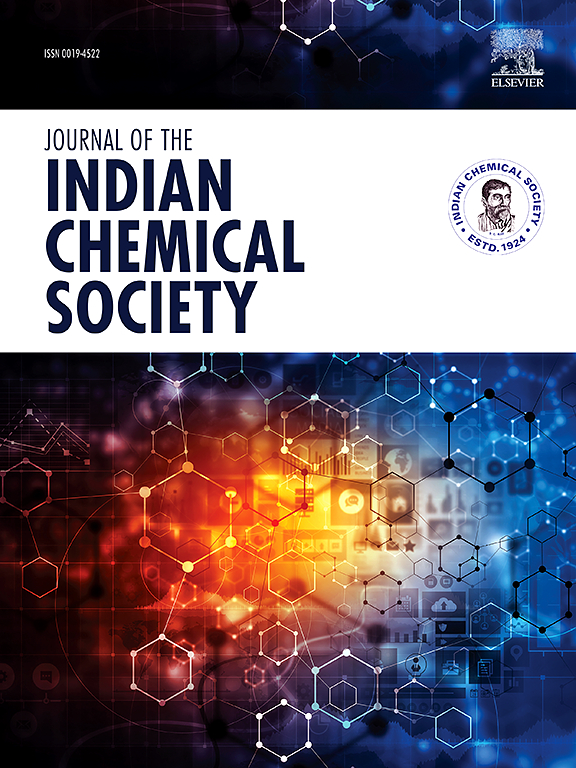D-phase emulsification of neem oil and its application on cotton and silk using response surface methodology
IF 3.2
4区 化学
Q2 CHEMISTRY, MULTIDISCIPLINARY
引用次数: 0
Abstract
Functionalization of textiles using natural plant-based agents is an emerging strategy to enhance comfort, health benefits, and environmental sustainability. This study investigates the development and application of a neem oil-based emulsion for imparting multifunctional finishes to cotton and silk fabrics. Neem oil, recognized for its potent antibacterial and antifungal activity, was emulsified via D-phase emulsification, optimized using Response Surface Methodology (RSM). Optimal emulsion stability was obtained with 5 % neem oil, 2 % surfactant, and 2 % glycerine. The optimized emulsion was applied onto marigold-dyed cotton and silk fabrics, using the pad–dry–cure method. The finished fabrics demonstrated excellent antibacterial activity, with 99.36 % (S. aureus) and 99.62 % (E. coli) inhibition on cotton, and 99.23 % and 98.32 % inhibition on silk, respectively, before washing. Even after five wash cycles, over 79 % inhibition was retained, confirming the treatment's durability. UV protection improved markedly, with UPF values increasing from 18.75 to 19.85 (cotton) and 22.65 to 25.03 (silk) post-finishing. Tensile strength showed slight reduction (cotton: 10.18 to 9.58 kgf; silk: 9.06 to 8.62 kgf), while hand feel was enhanced from grade 4 to 5. The color strength (K/S) values exhibited only a marginal decline (cotton: 2.8 to 2.6; silk: 3.7 to 3.4), indicating minimal impact on dye depth. This study validates the application of neem oil-based emulsion as a sustainable, durable, and effective bio-finish, imparting antibacterial, UV-protective, and tactile improvements without compromising core fabric properties. The results support its potential for eco-functional textiles in apparel, healthcare, and lifestyle applications.
用响应面法研究印楝油的d相乳化及其在棉花和丝绸上的应用
使用天然植物基剂对纺织品进行功能化是一种新兴的策略,可以提高舒适性、健康效益和环境可持续性。研究了印楝油基乳液在棉丝织物多功能整理中的应用。印楝油具有较强的抗菌和抗真菌活性,采用d相乳化法对其进行乳化,并利用响应面法(RSM)对其进行优化。在5%印楝油、2%表面活性剂和2%甘油的条件下,乳液稳定性最佳。将优化后的乳液应用于万寿菊染色棉、真丝织物上,采用垫-干固化法。水洗后织物对金黄色葡萄球菌和大肠杆菌的抑菌率分别为99.36%和99.62%,对真丝的抑菌率分别为99.23%和98.32%。即使经过五次洗涤循环,仍保留了超过79%的抑制作用,证实了处理的持久性。处理后的UPF值从18.75提高到19.85(棉),从22.65提高到25.03(丝)。抗拉强度略有下降(棉花:10.18 ~ 9.58 kgf;真丝:9.06至8.62 kgf),手感由4级提升至5级。颜色强度(K/S)值仅略有下降(棉花:2.8至2.6;真丝:3.7到3.4),表明对染色深度的影响最小。本研究验证了印楝油基乳液作为一种可持续、耐用、有效的生物整理剂的应用,在不影响核心织物性能的情况下,赋予抗菌、防紫外线和触感改善。结果支持其在服装,医疗保健和生活方式应用的生态功能纺织品的潜力。
本文章由计算机程序翻译,如有差异,请以英文原文为准。
求助全文
约1分钟内获得全文
求助全文
来源期刊
CiteScore
3.50
自引率
7.70%
发文量
492
审稿时长
3-8 weeks
期刊介绍:
The Journal of the Indian Chemical Society publishes original, fundamental, theorical, experimental research work of highest quality in all areas of chemistry, biochemistry, medicinal chemistry, electrochemistry, agrochemistry, chemical engineering and technology, food chemistry, environmental chemistry, etc.

 求助内容:
求助内容: 应助结果提醒方式:
应助结果提醒方式:


